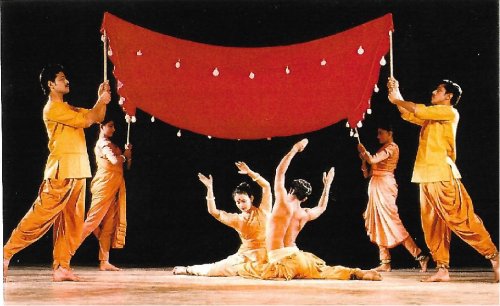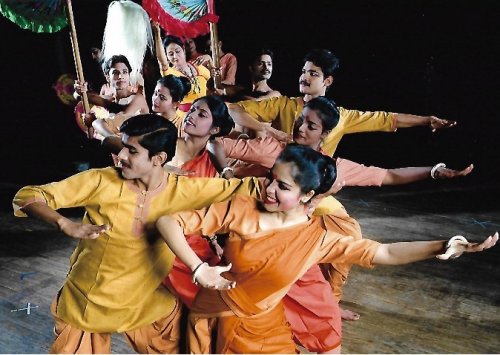
|   |

|   |
 e-mail: ukb7@rediffmail.com From Birth to Regeneration Photos courtesy: Dancers Guild December 24, 2017 Manjusri Chaki-Sircar has been a dancer extraordinaire all her life. Born half a decade before the onset of the Second World War and reared in a quaint town in the erstwhile East Bengal, she tumbled into dance as a tiny tot in enacting a Tagore poem, Pujarini (the Worshipper), culled from the Buddhist annals. The event was almost prophetic, presaging three trends of her later life. One, she would exalt in dancing all her living years till the very end of the century. Two, she would have a dominant influence of Tagore on her, alongside many other traditions and strains of Indian heritage. Three, religious anthropology would profoundly affect all her choreographic oeuvre: beginning with the Meitei Maibi worship of Manipur and ending with the Yatmul puberty ritual of New Guinea. Nava Nritya (literally, the New Dance) that she evolved in her long and illustrious dance career over half a century not merely took into account her own sound grooming in Indian classical dance styles, but also the martial arts of Kerala, Manipur and Mayurbhanj; the folk forms of Bengal and other Indigenous forms; and the daily living patterns. An astute dance critic observed once, "As a South Asian contemporary feminine choreographer, she was able to reassert her indigenous cultural autonomy, resisting not merely the bowdlerizing policies of the mainstream national streams, but also decolonizing her dancing body of the inherited and imported legacies of colonialism."  Yugasandhi (the Turning Point), presented on December 15, 2017 at Manjusri Sabhagriha by Dancers Guild of Kolkata, a body founded and nurtured by Manjusri, was set against critical political moments of the contemporary Indian history and came up as her creative statement against violence, war and disintegration in tender human relationship. Choreographed over the period between 1994 and 1998, it was her "swan song" bequeathed to Dancers Guild in Nava Nritya, based in particular, on sordid riots in Bombay in 1992-93, to which she was a horrified witness, at one end, and on the memory of the post-Partition sequel of disruption and disaster that she personally saw to seep into the collective life, at the other end. The first of the quartet of the evening's choreographic collage was on germination of life in the Vedic dawn of civilisation. It began with Surya Sukta from the Rig Veda, where the Sun is praised as the illumined vision of the entire cosmos, the very soul of the universe, and the divinity to set all life on the path of truthful action. He occupies a special place among the conclave of deities because of his direct visibility to all life. For one and all, he is a bestower of well-being and a provider of benign boon of welfare and hence he is to be prayed to and adulated. Since the Sun had impregnated Mother Earth for genesis of all life, this was followed by Prithvi Sukta from Atharva Veda that began with the ode: May truth, high and potent law, the consecrating rites, fervour and sacrifice uphold the Earth; May she, the queen of all that is and is to be, make ample space and room for us.... The ode ended thus: O Earth, my Mother, set me happily in a place secure, of one accord with heave; O Sage, set me in glory and in wealth.... The second segment visualised the birth and growth of the cohesive forces of civilization, definition of human bonding, and celebration of life through feasts and festivals. If the first part was a sombre recapitulation of the primordial creative process in taut choreography, what followed were brisk movements, signifying community joy and ecstasy, with folksy steps, swaying and undulating of torsos, and many circular and linear formations of exuberant dancers on front and back stage. The nuptial rites under the canopy, adoration of the child, the virtual 'swing' and the celebratory mode in general were well etched.  Then came the penultimate cataclysmic moments: the intrusion of doubts and dissents, the false groupings - to mark polarization of relations - and the ensuing clashes and conflicts. Many memorable vignettes were created: the horrid contours of hatred, the disintegration and distrust, and the naked violence that ripped apart castes and communities on imagined lines. This was the most moving segment of the choreography - the breakdown of the pillars of society, the fractured sensibilities of modern men, and widespread destruction and demolition of the human species, culminating in ghastly piles of putrid corpses. The finale, like the rise of the proverbial Phoenix from the ashes, saw the re-advent of human hope heralding a new era. This was echoed by the inspiring verse from Aitareya Upanishad: As honeybees buzz ceaselessly to gather nectar, as birds keep winging their way through the void, as the Sun perpetually emits its glow, so keep moving, forge ahead - Charaiveti, Charaiveti... Yugasandhi was a courageous piece of work, but occasionally it seemed like a work-in-progress, since the music had discontinuities and the inter-segment intervals occasionally fell silent. This critic, however, would hail Manjusri's magnum opus, which sincerely needs to forge ahead into new themes and fresh directions.  Dr. Utpal K Banerjee is a scholar-commentator on performing arts over last four decades. He has authored 23 books on Indian art and culture, and 10 on Tagore studies. He served IGNCA as National Project Director, was a Tagore Research Scholar and is recipient of Padma Shri. Post your comments Please provide your name and email id when you use the Anonymous profile in the blog to post a comment. All appropriate comments posted with name & email id in the blog will also be featured in the site. |